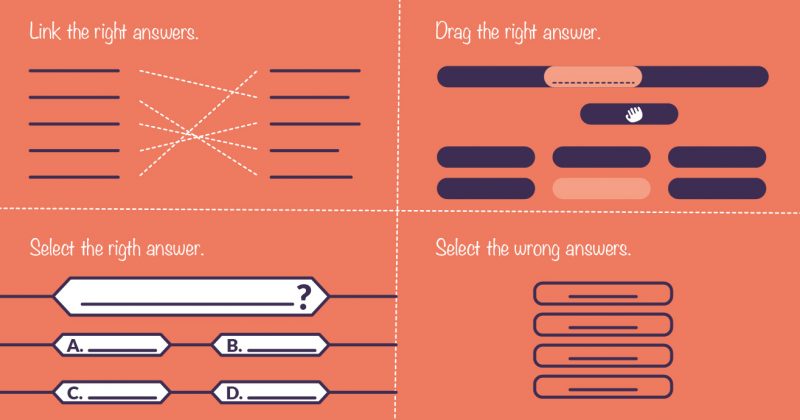In eLearning training programs, quizzes, or other MCQs are tools for assessing and validating learning. This is very appreciated by the eLearners: they can check the good understanding of the modules and measure their efforts. So how to make relevant quizzes and how to use them wisely?
Here 5 tips to optimise your eLearning quizzes:
1. Design the questions keeping in mind the educational objectives

Ask questions at the end of each chapter so that the learner can apply his / her new knowledge directly.
2. Write clear questions
It is essential to avoid using technical jargon or formulas in the questions. The goal is for learners to understand what is expected of them quickly.

If the question is too long, or requires several re-readings before understanding, learners may lose their patience and respond quickly without really thinking. So stay clear and precise.
3. Use multiple forms of questions
Today there are many question formats available to enrich the eLearning modules. The ideal is to mix the different forms, to keep the interest of the learner and not to make the exercise monotonous. Quizzes, hole sentences, open questions, drag-and-drop …

And feel free to try other evaluation techniques such as video examples or case studies.
4. Do not try to trick the eLearners
 It is not a good idea to propose “trick questions”, especially if it has elements of answer that are not in the module’s content. The goal here is to help learners memorize key messages and to objectively evaluate the achievement.
It is not a good idea to propose “trick questions”, especially if it has elements of answer that are not in the module’s content. The goal here is to help learners memorize key messages and to objectively evaluate the achievement.
5.Do not skip the step of writing answers to questions
It is essential, as you can imagine, to explain the answer to the question. It is not enough to simply say “good” or “wrong”. For each response proposal, take the time to explain why such a response is good or false.
– An eLearning video must last at least 15 min.
False
-> But what is the correct answer?
Why is it wrong, is the duration too long or too short?
False, ideally an eLearning video takes less than 10 minutes to keep the viewer’s attention from A to Z.
Just like for writing the questions, here we must not lose the interest of our learners. It is necessary to remain concise and clear, in order to favor the assimilation of all new information.
Conclusion
Questionnaires are an essential step in an eLearning program. We must take the time to think about the relevance of each question, and as we have seen, each answer. After a few tests of your eLearning program, you will be able to evaluate the scores and note the feedbacks of your learners. You will then be able to measure the correct understanding of the questions, correct any mistakes or add elements that you have omitted. Your eLearning program will improve as you go!

 by:Laura Schmitz on: January 5, 2018
by:Laura Schmitz on: January 5, 2018
-2.png)
